Mladen and Del review ‘A Christmas Chronicle 2’

Image courtesy of Netflix.
“The Christmas Chronicles 2” Starring Kurt Russell, Goldie Hawn, Darby Camp, Julian Dennison, Jazhir Bruno, Darlene Love, and others. Directed by Chris Columbus. 115 minutes. Rated PG. Netflix.
Mladen’s take
Kurt Russell as Dexter in “The Computer Wore Tennis Shoes.” Charming and prescient. Russell as Jack Burton in “Big Trouble in Little China.” Funny and athletic. Russell as Snake Plissken in “Escape from New York.” Kick-ass awesome and honorable. Russell as MacReady in “The Thing.” Perfect and human. Russell as a demigod in the second “Guardians of the Galaxy.” Nicely two-faced. Russell as Santa Claus in “The Christmas Chronicles 2?” Yup, he pulled it off.
I’ll let Del, the artistic, detail-oriented plot summary know-it-all blowhard describe “The Christmas Chronicles 2” storyline below. But, it’s enough here to note that Santa Claus and Mrs. Claus (Goldie Hawn) do PG battle, with support from a couple of kids, to save Christmas and the soul of an elf gone bad.
“Chronicles 2” is a neat story with good enough acting by everyone, with one exception: Russell. He’s the standout in this film. And, I’ll be damned, if his singing – that’s right, singing – isn’t good, too.
You’ve probably registered by now that I consider Russell one of the world’s greatest actors. It’s possible that merely his presence in “Chronicles 2” is enough to make me put on rose-colored glasses before I review the film. Not so. It’s clear that Russell had enthusiasm for his role. It’s that enthusiasm that carries the film. Russell’s Santa Claus is what the former St. Nick ought to be, a tough guy with a big heart.
We meet Santa as he mushes his flying reindeer in low-level pursuit of the dastardly Yule cat, an intimidating creature with, as it turns out, a coward’s will. Santa is as adept at maneuvering his sleigh as Plissken a glider, MacReady a flamethrower, or the Guardian’s demigod a planet. Russell’s and Darlene Love’s vocals in “The Spirit of Christmas” is boosted by their addictive fervor. The uplifting song, backed by a troupe of dancers, rocks.
Be patient with Mrs. Claus. Hawn seems a bit, I don’t know, stiff, uncomfortable, somewhat slightly off when we’re introduced to her character, but she gets better as “Chronicles 2” moves along.
The principal children in “Chronicles 2,” Kate and Jack are portrayed adequately by their actors. Belsnickel, the wayward elf is OK, too. I didn’t consider any of them unlikeable or unsympathetic, but they weren’t all that likeable or sympathetic either.
By the way, it seems that you don’t have to watch the original “Chronicles” before watching “Chronicles 2” to enjoy the latter. There’s enough backstory in “Chronicles 2” to satisfy curiosity about “Chronicles 1.”
I don’t recommend that religionists, particularly soulless evangelical muthers and counter-progressive Catholics who support imbecile lame duck poser president Trump and his immoral, nonwhite people-hating administration, watch this film. The movie has “Christmas” in its title, but Christ plays no significant role. In some ways, “Chronicles 2” is a Santa origin story and it uses the star of Bethlehem to help carry the plot.
I have no urge to put “Christ” back in “Christmas” as will be displayed by yard signs and bumper stickers sure to go up in the next couple of weeks in my part of Florida. For me, Christmas is about presents, the company of family, and good food. For the “Chronicles 2,” Christmas is the time of year for all people everywhere to come together to share good will and express hope for a better future. Hear, hear … as long as I get presents.
Russell gets an A+. “The Christmas Chronicles 2” is B-ish. “Elf” remains my favorite Christmas movie with real people and “Rudolph the Red-nose Reindeer” my favorite animated Christmas film.
Del, take it away. Try to avoid the pedantic, will you?
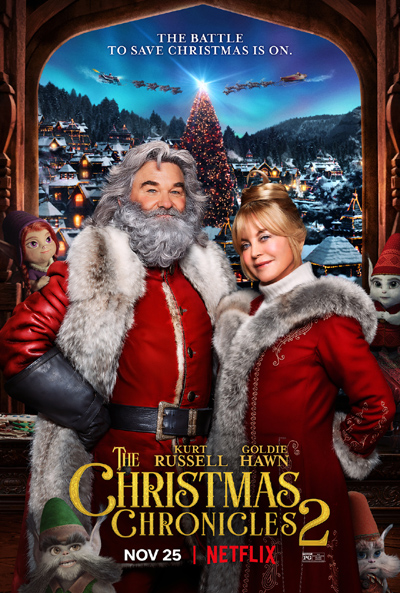
Del’s take
Hmphf. Mladen telling me not to be pedantic is like Hitler telling Stalin not to be mean.
It was my suggestion we review “The Christmas Chronicles 2,” folks. That’s right. I went out on a limb, after having once been stung by our deviation from the sci-fi/horror/action formula by reviewing “The Jane Austen Book Club,” aka “Plan 9 from Palo Alto.” I still have sympathy stomach cramps after that one. While “Christmas Chronicles 2” was nowhere near as bad, it is no “Reservoir Dogs.”
Because Mladen was too lazy to review the plot, I’ll fill you in:
Kate Pierce (Darby Camp) is now (because she also starred in the original “Christmas Chronicles” released in 2018) a typically entitled teenager who is pissed because her mother (Kimberly Williams-Paisley) dragged her and her brother, Teddy (Judah Lewis) to Cancun for the Christmas holidays along with new boyfriend Bob (Tyrese Gibson) and his son, Jack (Jahzir Bruno).
(Sheesh, is that enough parenthesis for you?)
Kate would rather be home for the holidays with her friends, the snow, and her angst. Mom moving on in life after Dad shuffled off this mortal coil was not part of Kate’s unified field theory and like every other teenager in every other movie in which a parent passes on, Kate wants to punish Mommy Dearest for allegedly “forgetting about Dad.”
She hatches an evil plan to catch an early flight back to the frozen wasteland of home, but things go off the rail when Belsnickel (Julian Dennison), an elf who has fallen from grace, snatches Kate and young Jack as part of his own evil plan. Via wormhole they’re transported to the North Pole and left in the cold for Santa (Kurt Russell) to rescue. Santa carries them through the protective shield surrounding Santa’s Village (Mrs. Claus’ Village?) and Belsnickel hitches a ride inside so that he may steal the Christmas star, a kind of lodestone for the Star of Bethlehem that powers the village and makes our capitalistic, consumer-driven Christmas hell possible.
What ensues is a series of mildly amusing vignettes barely held together with a gristle of plot. Suffice it to say that along the way snotty Kate will learn not to be such a selfish, moody brat. All the other trifling conflicts get wrapped up in a sparkly red bow. Spoiler? Well, no. These movies are as predictable as the depressing deficit in my checking account at the end of each month.
I won’t tell you “Christmas Chronicles 2” is a bad movie. It’s not. It’s stupid and irritating and has plot holes bigger than a collapsed Christmas star, but it’s not bad, not like “The Jane Austen Book Club.”
But it did irritate me. Every year, starting about mid-November, we’re inundated with so-called Christmas movies about those people … the ones with halogen teeth and taxidermed eyes who live in a Norman Rockwell vision of Christmas where the snow is virginal and the trees decorated in symmetrical splendor. Everything is “Stepford Wives” perfect, and the characters manage their tiny holiday peccadilloes with such gentle dexterity you wonder if they’ve ever stubbed a toe or broken a nail.
C’mon. We all know our teeth are yellowed, our eyes bloodshot, the snow will turn to muddy slush and the tree looks like it was decorated by a tweeker. But that’s OK because life is life. Let’s have a Christmas movie where Uncle Bob has to change his underwear because he made the mistake of trusting a fart.
It’s possible. I recommend “The Homecoming,” a 1971 movie starring Richard Thomas and Patricia Neal. It was the genesis of “The Waltons” TV series that aired for nine years starting in 1972. The story is about a Depression-era family in rural Virginia waiting for the father to come home on Christmas Eve during a blizzard. It accurately and effectively portrayed the desperate poverty of those years, and the simple yet heartfelt hopes and dreams of the people who endured that terrible time. It was way better than any frothy confection from The Hallmark Channel or, in this case, Netflix.
“Christmas Chronicles 2” is way too preachy and precious for my tastes. I watched it, I didn’t hate it, and Kurt Russell was awesome (the kid who played Jack was also awesome). But before watching a “Christmas Chronicles 3” I’d want to get my blood sugar levels checked.
People who enjoy the occasional sip of feel-good holiday movies will get their eggnog’s worth from “Christmas Chronicles 2.” Just don’t expect a shot of rum in that glass.
I grade it a B-.
Mladen Rudman is a former journalist and technical writer. Del Stone Jr. is a former journalist and author.
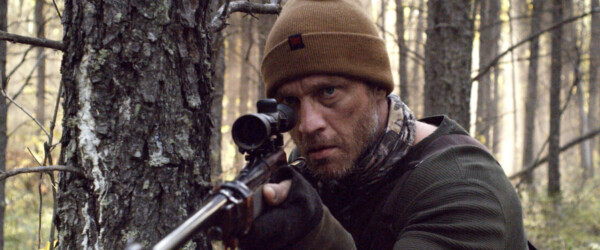
Image courtesy of IFC Midnight.
“Hunter Hunter” Starring Devon Sawa, Camille Sullivan, Summer H. Howell, Nick Stahl. Directed by Shawn Linden. 93 minutes. Unrated. Netflix, HBO, Hulu, YouTube.
Spoiler alert: This review contains reveals that are meaningful to the climax.
Del’s take
Remember Devon Sawa?
In the 1990s he was a teen heartthrob, bowl cut and all, starring in movies like “Casper” and “Final Destination.” Today Sawa is all grown up, a husband, father, and author of a dementedly hilarious twitterfeed at @DevonESawa . He’s also the lead in today’s stream gem, “Hunter Hunter.”
Fair warning: “Hunter Hunter” is not for everyone. It is dark and bloody. One scene is an over-the-top gorefest. I don’t usually go for that sort of thing but I found myself watching “Hunter Hunter” for the story and acting. The story was thin but fairly compelling. The acting was top notch.
Sawa plays Mersault, who lives in a northern backwater with his tremulous wife, Anne (Camille Sullivan) and daughter Renee (Summer H. Howell). Mersault is stubbornly dedicated to their impoverished and primitive lifestyle, believing salvation lies just around the corner with the next animal trapped and the next varmint extinguished. Speaking of which, a rogue wolf has entered their realm and is poaching animals from the traps Mersault has strung throughout the forest. Without the pelts those animals provide his family will starve, reason enough for Mersault to stalk the wolf and Anne to want to relocate into town, where a real house awaits and Renee can attend school.
During his wanderings Mersault comes across a grisly scene – a dump site for a serial killer. Incredibly, he does not report his discovery to authorities but decides to hunt the new predator himself. Meanwhile, a broken-down car introduces Lou, a nobody who is found crawling through the woods, injured and bleeding. Anne brings him to the family cabin for recuperation. From there, disparate story threads begin to converge, with horrifying consequences for all involved.
I have gripes with director Linden’s handling of “Hunter Hunter.” To begin, Mersault’s backstory needs beefing up. Why does he cling to a lifestyle his wife seems to hate? How is he able to dictate their living conditions with little argument from Anne or Renee?
Also, I have a problem with viewpoint. The story is told through the Mersault character until it reaches a certain point, where the viewpoint shifts to Anne. This change telegraphs an important plot resolution. I have no problem with changing viewpoint characters in movies but if Linden had employed the technique throughout instead of only when it became necessary, he might not have given away the ending.
Speaking of that over-the-top scene … the movie could have gotten along just fine without it. I’m not a fan of terror through shock. Tension is a much better source. Linden is able to do that in his building of the conflict between Mersault and the wolf, especially when Renee becomes a piece on the chess board. But once the blood starts gushing, all I felt was disgust.
Sawa had remained a child star in my memory so it was great to see him as an adult. He was fully convincing as Mersault, as were the other actors in their roles, and I look forward to his future movies. The setting of “Hunter Hunter” was lush and verdant, the cold palpable. It helped me appreciate the struggle that was their life in the woods.
If overt brutality and gore are not for you then I won’t recommend “Hunter Hunter.” If not, give it a watch. Despite its flaws it’s an interesting movie that will remain top-of-mind for days.
I give it a B.
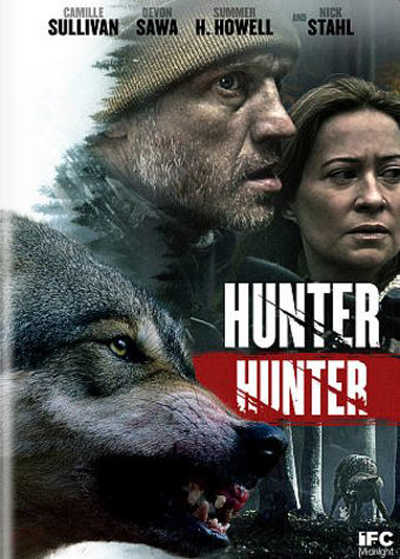
Mladen’s take
No, Del, I didn’t remember Devon Sawa. Could care less that he was a child star or that he has a twitterfeed. Nearly everybody has a twitterfeed because Twitter is open to nearly everybody, which leads to a planet-load of crap floating in cyberspace. Even Trump’s ban from twitter doesn’t keep the Twitterverse from ranting about the injustices committed against the one-term, poser president fascist dickhead. Twitter, Facebook, TikTok, Instagram, whatever, should burn in hell.
And, Del, because you’re clearly disinclined to level with our dear readers, let me define for them what you mean by “over-the-top gorefest.”
Torture pornography. That’s where the subplots in “Hunter Hunter” converge. The bad guy, fully conscious, is vivisected by the broken mother. The only redeeming part of that prolonged encounter between him and her wielding the tools of skinning and de-organing animals was the song playing in the background. It might have “narcissist” in its title, but I’m not sure. The song was ominously mellow with a touch of psychosis. Loved it.
“Hunter Hunter” starts OK enough. Dad Mersault teaching his daughter Renee the ways of the boreal forest of Canada is neat. He’s an animal trapper and she’s a trapper trainee. The plot establishes quickly and efficiently that Mom Anne was sufficiently content with the 18th Century life her husband wanted to live when they were newlyweds or Renee was still young. But, now, Renee needs true schooling, the pelts are worth much less, and the few the family is producing are fewer because a wolf has been raiding the traps. Mersault wants to stay in the woods. Anne is eyeballing life in a town. Renee is caught between. Understood.
“Hunter Hunter” then starts to degenerate. The first hint of the trouble on the way is Anne starting to worry that the wolf is directly a threat to them, as in it wants to eat the family. Any seasoned outdoorsman or environmentalist knows wolves are no threat to people. So, “Hunter Hunter” uses the cheap ploy of making the trap-raiding wolf the wolf of the fairy tale Little Red Riding Hood to build tension and allow misdirection. Didn’t buy it.
Then, as Del notes, “Incredibly, (Mersault) does not report his discovery to authorities but decides to hunt the new predator himself.” The discovery is, of course, the cache of female corpses left by a serial killer and rapist. What the hell? Yes, Mersault is a man’s man. He knows the woods. He can trap animals, but is the skill of trapping animals applicable to the skill of hunting and capturing a demented human being? And, by the way, I assume murder is against the law even in backwoods Canada. Wasn’t Mersault obligated to call a Mountie?
As the story unfolds, Marsault becomes the hunted, the hunter of Mersault continues to hunt, but then he becomes the hunted. Maybe the film should’ve been called “Hunter Hunter Hunter.”
The film has wonderful cinematography. The north woods are breathtaking. I agree with Del, the acting is good. There’s a couple of nice-touch quick glimpses of something amiss. None of the above, however, offsets what “Hunter Hunter” transforms into during the last, oh, 5 minutes of its run. “Hunter Hunter” is a C and that’s generous.
Mladen Rudman is a former journalist and technical writer. Del Stone Jr. is a former journalist and author.

Image courtesy of KFC/Lifetime.
“A Recipe for Seduction” Starring Mario Lopez, Justene Alpert, Chad Doreck, Emily Lemos, Martin Morrow and Tessa Munro. Directed by Eric Eckelman, Armand Prisco and Natalie Prisco. 15 minutes. Rated TV-PG. Lifetime.
Del’s take
Wow, that was the longest TV commercial I’ve ever seen, longer than the wait time for a 20-piece bucket at the KFC drive-thru.
Yeah, I know Lifetime is pitching “A Recipe for Seduction” as a “mini-movie” but c’mon. They know and you know and I know it’s really just an ad for Kentucky Fried Chicken. Hell, I’m picturing the $5 lunch special as I write this and it’s not even second breakfast.
“Recipe” kind of offends me because it represents the further contamination of an art form for the pedestrian enrichment of a giant corporation. It is to movie-making what Donald Trump was to the presidency – one giant, polluted fuckup that left us all with spiritually clogged arteries.
On the other, I don’t think anybody is taking things too seriously, especially the folks at KFC and Lifetime. “Recipe” makes no effort not to laugh at itself and because of that I can’t be too offended. Mladen can, but I can’t.
The plot, if you can call it that, goes as follows: Young Jessica (Justene Alpert) is being set up to marry the obnoxiously wealthy Billy Garibaldi III (Chad Doreck) by Jessica’s evil mother Bunny (Tessa Munro). It’s a marriage that must happen if Jessica’s family is to remain solvent, but she doesn’t love Billy because he’s a chicken dick. Instead, the hot new chef, Harlan Sanders, looks finger-lickin’ good, and his secret recipe for fried chicken promises a level of wealth that might even keep Bunny in style if she could just stop being evil and consider the possibilities.
Will Jessica marry the rich goldfish or go with the chicken fingers? Will Bunny stop meddling in Jessica’s affairs and let love find its pecking order? And who was that hot guy Jessica’s gay pal Lee (Martin Morrow) went out with; anybody got his phone number?
The one thing I loved about “Recipe” is that it ended before I could actively start hating it – otherwise I would have choked on a chicken bone of bad acting, soapy melodrama and clichés that should have gone to roost centuries ago. I mean, the whole ad/movie/whatever is nothing more than a retelling of Cinderella, except Cinderella ends and “Recipe” doesn’t. That’s right. We might be talking sequel.
Which I’ll skip, by the way, because some things are better left to the digestive tract and “Recipe” is one of ’em.
Still, I won’t seriously criticize either Lifetime or KFC because “Recipe” is played mostly for sillies. Its primary mission is to get people talking about Kentucky Fried Chicken and in that respect it succeeds and then some.
As entertainment I’d give it a C-. As advertising it earns an A+.
And now I hand the conversational baton to Mladen for one of his rigid, doctrinaire rants. Somebody distract me with a two-piece box of extra crunchy please.

Mladen’s take
Del has 16 minutes to live. That’s how long it’ll take me to get to his house to bludgeon him to death with a KFC drumstick. Why must Del be sent to the Great Poultry Processing Plant in the Sky? Because he made me watch “A Recipe for Seduction.”
I chose 16 minutes, by the way, as Del’s remaining duration on Earth, because that is the runtime of “Recipe,” which should be subtitled, “Who the Hell Would Watch this Crap or Spend Money to Make It?”
Del summed the plot or, more accurately, the KFC sales pitch nicely. So, to drive the stake home, I’ll quote a few lines for your benefit. That should be enough to deter you from blowing time watching this used cooking oil of a feature.
Our heroine Jessica, after falling head-over-heels for the Colonel, confesses to her friend, “He tells me that he has a secret recipe that will change the world. I believe in him.”
Jessica’s rich cad of a boyfriend slanders the Colonel by calling him “crouton.” The Colonel responds courageously, “Don’t call me crouton.”
For a moment, I had hope for “Recipe.” It was foolish, my hope. I knew that my hope was foolish even before it bubbled to the surface and burst on the rocks of the advertisement’s G-rating. At one point, Jessica goes to take a shower. I was hoping the camera would follow her in. No luck.
OK. I just spent more than 16 minutes to write this review. That means I’ve wasted at least 32 minutes of my life on this Lifetime TV special. That stops now.
I can’t give “A Recipe for Seduction” a grade. That’s reserved for actual films. What I can do, is give Del a warning. Del, I’m stepping into my car now. See you in 16.
Mladen Rudman is a former journalist and technical writer. Del Stone Jr. is a former journalist and author.

Image courtesy of Netflix.
“The Midnight Sky” starring George Clooney, Felicity Jones, David Oyelowo, Caoilinn Springall, Kyle Chandler, Demian Bichir, Tiffany Boone, and others. Directed by George Clooney. Runtime 118 minutes. Rated PG-13. Netflix
Mladen’s take
Rank the essential components – acting, directing, score, cinematography, and script – of “The Midnight Sky” individually and the results vary from good to very good. Combine the essential components of this Netflix production and the result is mediocrity.
It’s not that “Midnight,” despite its Adam-and-Eve ending and a twist that turned out to be, what, a terminal-cancer-driven hallucination, is entirely disappointing. It’s that its subplots weren’t particularly absorbing. Nor were its way-too-many characters consistently worth caring about.
In “Midnight,” the year is 2049 (maybe that’s a nod to 2017’s “Blade Runner 2049”) and the jig is up for humanity. Actually, it’s the end for anything that breathes air as we know air today – mostly nitrogen, some oxygen, and a little bit of carbon dioxide, i.e. not enough to poison us. Before our planet’s atmosphere turned into a swirl of unbreathable toxic gases, mankind mounted an expedition to a newly discovered Jovian moon that could support complex life. The crew of the vessel was on its way home from a recon of moon K-23 when Mother Earth, reacting to our abuse of her, transformed into Serial Killer Earth. Augustine, portrayed by George Clooney, and accompanied by a young girl, has to make way for a weather station that likely has the capability to communicate with the spaceship returning to Earth. He wants to warn the crew that our planet is no longer habitable and offer a suggestion – return to Jupiter’s moon to re-plant our species on a pristine solar system body.
Why cosmologist Augustine feels he has to alert the crew of a spaceship built to probe a moon for signs it can support life that Earth is unsafe for them is beyond me. As the spaceship approached Earth, it was clearly visible to its crew that the planet’s atmosphere, now a green-yellow, had changed since they departed two years earlier. I’m no astronaut, but a discolored home world would have me saying something like, “Ensign, give me scans of the planet in UV and IR. What’s the spectroscopy saying about chemical composition of the atmosphere?”
The spaceship has a crew of five, one of them Felicity Jones’s Sully, a pregnant communications specialist. As the spaceship’s sub-story unfolds through a course deviation, collisions with space rocks, and an assortment of personal anguish, one crew member dies, two decide to return to Earth the Stomper of Life via a lander, and two slingshot back toward K-23.
I predict Del will like this movie, giving it a B+. He’s like one of the dudes in “Midnight” who decides to go home, though home will kill you for sure. Del will strain to find the positive in “Midnight” like the movie’s Earth returners hoped to find family still alive. Don’t be fooled. “Midnight” ain’t that good.
The best you can expect from “Midnight” is a few bits of good storytelling backed by consistently good acting. The film’s score is sturdy, if not exceptional. It helps the tale by setting up moods. The visual effects in “Midnight” are very good. I enjoyed the cinematography the most when it conveyed the austere and stark blue whiteness of snow cover and ice pack in the North Pole. But, even that simple joy was harassed by an achy nagging at the back of my brain. As mentioned above, “Midnight” takes place in 2049. Ain’t no way there’ll be any ice pack or glaciers anywhere on Earth in 28 years. Want ice then? Place your glass beneath the ice dispenser on your refrigerator.
“The Midnight Sky” gets a C+ from me. Del, on the other hand, will likely nominate it for a best picture Oscar.
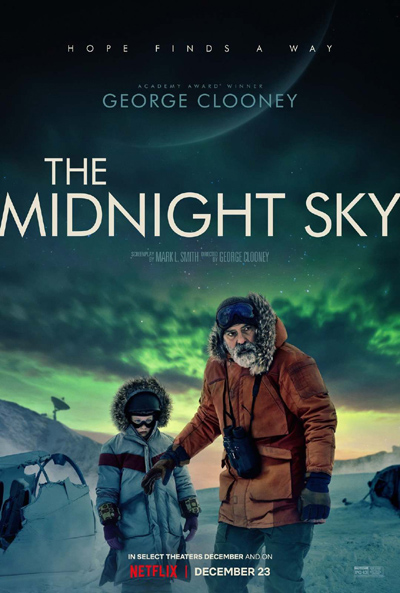
Del’s take
Merry Christmas, you old coot. Sounds like you’re sipping more of the “nog” than the “egg.”
You think I liked “The Midnight Sky”?
Piffle. Do I like any movie?
Folks may think I’m a serial hater but trust me, there are movies I adore – “Being There,” “Doctor Strangelove,” and “Die Hard” to name a few. “Midnight Sky” ain’t one of them.
Not to nerd out on all three of our readers but “Midnight” lost me at the opening narrative where we are informed mankind has discovered a “new moon” around the planet Jupiter, one that has the ability to support terrestrial life.
Oh, sweet Jesus, somebody hand me one of George Clooney’s barf bags.
To put it politely, that’s a preposterous crock of ca-ca. There is no more an undiscovered moon of Jupiter capable of supporting “The Property Brothers” than the Earth is flat, climate change ain’t happening and Donald Trump was an effective and cordial president.
(Yes, I did have to get my Trump bash in.)
With all the space probes we’ve sent to Jupiter – hell, we’ve got one there right now photographing everything from moons and lightning bolts to Jupiter getting out of the shower – the chances of a large moon escaping our carefully studied inspections are nil. Not almost nil. Totally, completely and incontrovertibly nil. Nil nil nil, as in where have you been the past 30 years and you’re an idiot for even suggesting such a stupid departure from reality.
Seriously, it isn’t written in stone that a movie’s science must be accurate. Obviously the science of “Star Wars” is so far off the mark it qualifies as fantasy, and let’s not talk about movies like “Godzilla” and “Transformers.” But if you, the moviemaker, present the science as a pillar of the film’s premise, then you must make sure it’s consistent – or at least plausible – with what we already know. Had the makers of “Midnight” consulted a single astronomy buff they could have adjusted their ca-ca premise.
OK, enough nerd stuff. I can see two of our readers are asleep. Suffice it to say the scientific implausibilities that I mentioned, along with those Mladen noticed even in his nogged-out state, pretty much ruined the movie for me.
The rest of “Midnight” is a depressing pastiche of tropes and science fiction clichés interspersed with scenes of George Clooney throwing up. Was anybody else grossed out by the vomit in his Unabomber beard? Funny, the ca-ca Hollywood thinks people want to see. As for Mladen’s “consistently good acting,” I’m sorry but what the hell was he smoking? Clooney’s narcoleptic performance failed to impress despite the bombastic promotionals. The only actor who showed the tiniest sign of life was Kyle Chandler, who uttered one laugh-out-loud line. The plot consisted of a series of contrived and impossible cliffhangers. The script seemed inspired by “A Recipe for Seduction” in terms of silliness and the movie as a whole struck me as Frankensteined from bits and pieces of “Gravity,” “Interstellar” and other mediocre SF films.
By the way, “We messed up” is not sufficient explanation for the end of the world.
What’s good about “The Midnight Sky”?
The special effects are pretty. Sound of crickets chirping. I can’t think of anything else.
What irritates me is “Midnight” could have been an excellent movie. The problems could have been fixed easily enough so that grouchy old bastards like Mladen and me could go back to grumping about our prostates. It’s just sloppiness and laziness, and as a storyteller myself it pisses me off.
I’ve recommended a lot of Netflix movies lately but if you miss this one you haven’t missed much. I give it a C-.
Mladen Rudman is a former journalist and technical writer. Del Stone Jr. is a former journalist and author.
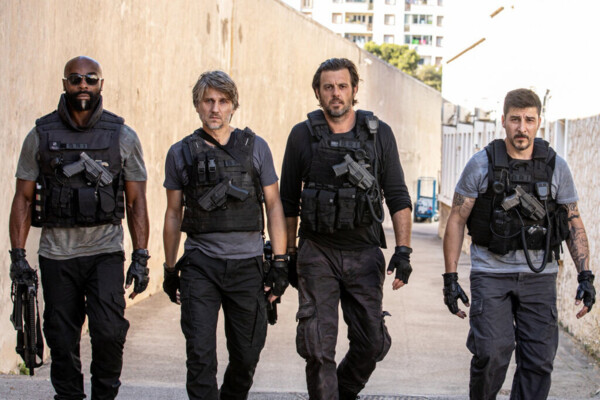
Image courtesy of Gaumont.
“Rogue City,” aka “Bronx” Starring Lannick Gautry, Stanislas Merhar, Kaaris, David Bell, Barbara Opsomer and Jean Reno. Directed by Olivier Marchal. 116 minutes. Rated TV-MA. Netflix.
Del’s take
What the hell is the name of this movie? “Bronx” or “Rogue City”?
It’s both. Released in some countries as “Bronx,” it appears on Netflix as “Bronx” and “Rogue City,” a bit much to ask of somebody in a vomit-soaked wifebeater waking up from a 12-beer bender.
Should you choose to go this route, prepare yourself for a gritty, nasty, violent crime drama where the line between cops and robbers, good guys and bad, is described perfectly by one of the kingpins negotiating a deal with anti-gang unit boss Richard Vronski (Lannick Gautry):
“You know the only difference between you and me? A police badge.”
That message is conveyed throughout the movie in a multiplicity of ways, straight to the bitter – and I do mean bitter – end credits.
“Bronx” is about a local police anti-gang unit operating to thwart the activities of drug gangs in Marseilles (yes, the movie is French, and it is subtitled, so there goes about 85 percent of the American audience). The unit has become as thuggish and brutal in its methods as the criminals it seeks to suppress, drawing the ire of Internal Affairs and other elements of the French law enforcement community.
As the story progresses we come to know that everyone in the Marseilles police department is in cahoots with the crime community EXCEPT some of the guys on the anti-gang unit. I’ll let you decide who’s on the take and who’s just an asshole.
The story is a typically bleak modern viewpoint, made special by its cinematography and explicit violence. I expect Mladen was disappointed by the level of mayhem, but to my sensitive palate “Bronx” was soaked through and through with shocking footage both overt and suggested. Don’t get me wrong. I’m not opposed to cinematic violence. But it must serve a storytelling purpose. In the case of “Bronx,” violence was the story.
Acting was solid, with the incomparable Jean Reno playing a role contrary to his character type. One of the pleasures I get from watching foreign movies is seeing how other people live, and “Bronx” provides an extensive look at that aspect of French citizenship. Apparently shiny floor tiles is a thing in Marseilles.
What I did not like about “Bronx” was its heavy-headed subtext and dystopian worldview. The chief of the anti-gang unit, Vronski, is named after a “motherfucker” from a Tolstoy novel, according to a crime boss, one of the few human-like creatures in the film. I would like to believe people are not as selfish and hateful as the Marseilles anti-gang unit and their persons of interest, but maybe I’m wrong. After enduring four years of the Trump administration I should no longer harbor such idealistic fantasies.
Still, “Bronx” is entertaining, though it requires a strong stomach for those sensitive to blood. I’m not sure what the title is meant to convey – maybe a European conception of what a crime-riddled American city must be like. If so, I would say America’s Bronx has nothing on Marseilles, which comes across a shootout away from total anarchy.
I would give “Bronx” a B.

Mladen’s take
It’s tough to tell. Am I tepid about the French movie “Bronx” because Del promised it was uber-violent but wasn’t? Or, am I disappointed because the cop/gang/drug war movie was disorienting?
Disorienting, how? Well, there were shifting alliances and billions of character names thrown around. There was not one single good guy or wonderful gal in the whole damn Netflix film. Not one. Yes, there were a couple of less than bad guys – the Internal Affairs investigator, for example – but a prominent good person would’ve helped me track the bad guys, which would’ve helped me follow the story. All the cops were corrupt or otherwise compromised, e.g., one cop screwing another cop’s wife. The drug gangs were, ah, Mexican cartel-like drug gangs. Fighting brutally for territory and respect, though their marketplace was Marseilles, a city of some 900,000 people. Wouldn’t it have been more productive for everyone involved to divvy the city into parcels using socioeconomic data to ensure each gang gets a fair and balanced share of jack from drug peddling?
By the time “Bronx” ends, you feel like you’ve been seeing from the inside the way the outgoing and bonkers Trump administration operates. Everyone inside the police department is part of clique that protects its own from the other cliques in the police department. Unflinching loyalty, rather than decency, honor, public service, or competence, is the play. Non-legal side hustles and betrayal are the norm. The drug gangs, think of one as Vladimir Putin and the other, oh, Recep Tayyip Erdogan, dick with each other until everyone but a cop unit from a different police department ends up dead. Absurd.
“Bronx” isn’t introspective. It isn’t didactic. It isn’t good versus bad. It’s bad versus an ever badder bad interwoven with the kind of incomprehensibility you find in films such as “Inception” or “Tenet.” The moral turpitude and nearly unfathomable complexity became tiring after a while. And, one of the movie’s principal firefights occurred at night, which, again, was disorienting. I had no idea who was shooting at whom. So, instead of a gun battle at the OK Corral, or whatever, the viewer gets muzzle flashes and plinking bullets from every direction amid vast deposits of black screen. Besides, if everyone in “Bronx” is a bad dude or dudette, who cares which one of them dies?
Wait. It just occurred to me. The reason I mostly disliked the movie. Its intrigue and violence reflected the malaise of normal life on Earth these days. “Bronx” relied on narcissism and nihilism to see it through. Its violence lacked the wholesomeness of the man vs. computer action in “The Matrix.” It wasn’t the survival violence of man vs. nature as portrayed in “Jaws.” It wasn’t the tired violence of a war fought too long as on display in “Fury.” It wasn’t the outrageous and playful violence of “John Wick” Chapter 1 and “John Wick” Chapter 2. “Bronx” violence was about the Euro with a dose of racism pitched in. Eh.
“Bronx” had some money behind it because its production value was good. The acting was decent. I saw no trouble with film editing. The score, though indistinctive, fit the movie well enough. I found myself imitating in pretend French the catchy song at the end of the film.
Bronx gets a C+ and Del needs to hone his definition of “violent.” This movie was no “Scarface.”
Mladen Rudman is a former journalist and technical writer. Del Stone Jr. is a former journalist and author.
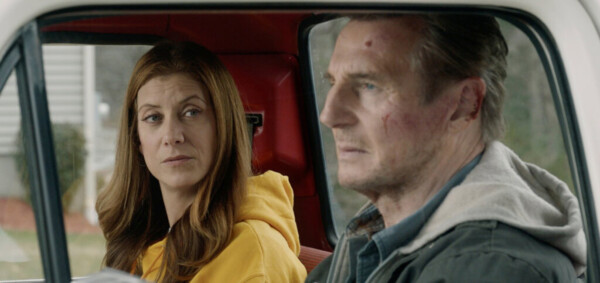
Image courtesy of Open Road Films and Briarliff Entertainment.
“Honest Thief” Starring hot Kate Walsh, old Liam Neeson, decent bad guy Jai Courtney, remorseful Anthony Ramos, skeptical but open-minded Jeffrey Donovan and others. Directed by Mark Williams. 99 minutes. PG-13. Amazon Prime.
Mladen’s take
“Honest Thief” is an honest-to-goodness mediocre movie. It pulls a C+. The film’s woes in a moment. I’m obliged to provide a summary first to sedate Del’s urge to nag me about it.
Liam Neeson as Tom Carter falls in love with perfect woman Annie Wilkins played by Kate Walsh. Carter decides that the relationship will suffer unless he comes clean with his dark past, which ain’t all that dark if you ask me. Stealing from the rich to keep some for yourself and give some to the poor is OK with me.
Anyway, Tom tries to confess to the FBI that he’s a long-wanted bank robber and cut a deal to serve less time in the hoosegow so that he can spend more time with Annie. As The Fixx will tell you, one thing leads to another and, pretty soon, Tom and Annie are on the run from a couple of corrupt FBI special agents trying to steal the money that he robbed from assorted financial institutions.
Toss in guilt trips, a murder or two and attempted murders, violations of the oath to serve and protect, EOD expertise, lots of PG-13 gun play, and a healthy house-destroying detonation and you’ve got a pretty standard tale of a somewhat bad man, a thief, attempting to do the right thing, be honest.
Casting old Neeson as an adroit, strong brawler and an ace car driver provokes one of my biggest movie-going peeves. Action films cannot be propelled by aged dudes. And, Neeson is gaunt to boot, so it’s impossible for him to use sheer bulk as the source of a powerful punch. I’m somewhat old and would, no doubt, break many a bone falling from a two-story window whether I’m locked in fisticuffs with a Bureau baddie or not. Hell, I’m not even convinced Tom would be able to lift the uber-drill he uses to break into bank vaults made of thick steel.
Even more of an impossibility is that someone as fine as Annie would fall for a semi-mummy-looking fellow such as Tom. That said, Walsh does a good job making the movie flow. She’s convincing as a girlfriend who goes from disbelieving and troubled that her beau is a bank robber to a willing accomplice intrigued by Tom’s techno-skills.
In fact, it’s getting to the point where I’ll consider watching a movie starring Walsh even if the genre is crap. For example, she was very good in “Grey’s Anatomy.” My daughter made me watch the show.
“Honest Thief” knows what it is. A passable film that’ll draw a sufficient number of viewers to make some bank. I imagine it also took no more than a week to make, freeing Neeson to shoot another film where he can pretend to be as strong as the 30-year-olds he’s fighting.
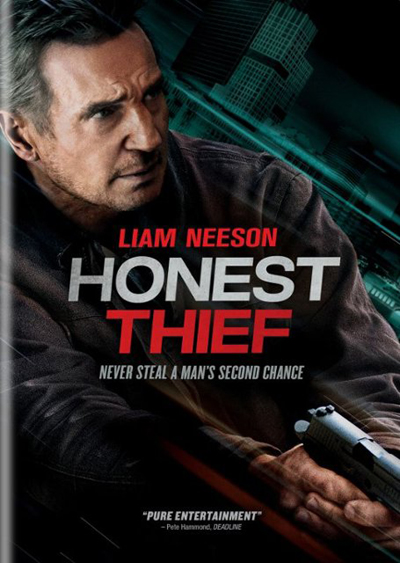
Del’s take
I would make a lousy Robin Hood because I am not as sanguine as Mladen about stealing from the rich to give to the poor. I thought the whole point of capitalism was to let people come up with a great idea, work their ass off, sell it for billions of dollars and enjoy the financial fruits of their labor.
Being rich doesn’t mean a person is evil. Breaking the rules and stealing – those things are evil. So with that thought I segue into my critique of “Honest Thief”: It was a decent enough action movie based on a ridiculous premise.
Throughout my viewing of I heard a voice inside telling me, “This is ridiculous. Nobody but NOBODY would behave like this.”
And by “this” I mean what Mladen wrote: “Liam Neeson as Tom Carter falls in love with perfect woman Annie Wilkins played by Kate Walsh. Dolan decides that the relationship will suffer unless he comes clean with his dark past … Tom tries to confess to the FBI that he’s a long-wanted bank robber and cut a deal to serve less time in the hoosegow so that he can spend more time with Annie. As The Fixx will tell you, one thing leads to another and, pretty soon, Tom and Annie are on the run from a couple of corrupt FBI special agents trying to steal the money that he robbed from assorted financial institutions.”
What Mladen omitted in his otherwise acceptable summary was the reason for Tom Carter’s bank-robbing spree. It was to avenge a miscarriage of justice inflicted on his father by a bank. I’m rolling my eyes as I write this.
THAT is a ridiculous premise.
What follows is a corny, formulaic beat-’em-up that explodes every house, falls off every ledge and lands every roundhouse you would expect from a man with a particular set of skills. Liam Neeson gimps his way through the plot with respectable dexterity – I mean, the guy is 68 years old, which is only two years older than yours truly, and I would not want to have my teeth kicked by anybody, much less a corrupt FBI agent. But I would agree with Mladen that maybe he’s a tad long in the tooth for those kinds of roles. To go on would be a mis-taken.
I enjoyed the action and I thought Kate Walsh and Jai Courtney were the standout actors. Neeson was his usual post-AARP good guy with a pacemaker. The characters were props for the action, however, and that’s what I remember best from “Honest Thief.”
Mladen gave the movie a C+. I’ll be a little more generous and say it’s a B-. The unbelievable premise knocks it down from a solid B.
Mladen Rudman is a former newspaper reporter and technical writer. Del Stone Jr. is a former newspaper editor and author.

Image courtesy of Silverback Films.
“David Attenborough: A Life on Our Planet” Starring David Attenborough. Directed by Alastair Fothergill, Jonathan Hughes, Keith Scholey. Rated PG. 83 minutes. Netflix.
Del’s take
The most heartbreaking moment in David Attenborough’s profound “A Life on Our Planet” takes place at about the halfway mark when we see an orangutan clinging to the shredded branch of a tree – one tree – remaining in a field of clear-cut Borneo rain forest. Surrounding this pitiful creature lies destruction – jagged stumps, mangled limbs, the earth scarred by monster bulldozers.
Gut-wrenching.
That brief snippet of video perfectly encapsulates the message of Attenborough’s documentary film about the downfall of the natural world and serves as a metaphor for the future of mankind as we greedily attack the systems that make life on Earth possible.
Attenborough has a unique perspective on this tragedy. His role as broadcast journalist and naturalist for the BBC has allowed him to see firsthand the rapid decline in animal species, the fouling of the earth and the collapse of ecosystems. As a result, “A Life on Our Planet” is “my witness statement and my vision for the future,” he says.
The first two thirds of the documentary are devoted to Attenborough’s career as a journalist-naturalist and the chilling litany of ruin and destruction he has witnessed since he began covering the “nature beat” in the 1950s. Then, the plains of Africa were covered with migrating herds of wildebeest and zebras, Antarctica was a deep-freeze of glaciers and penguins, and the oceans of the world were home to thriving coral reefs.
Compare that with today: The great herds of Africa are diminished to a trickle, with some species, like the white rhino, becoming extinct. Glacier coverage around the world has shrunk, contributing to sea level rise and the possible extinction of animals like the emperor penguin. Coral reefs are dying as the oceans heat and become more acidic.
Attenborough tries to describe the relationship that exists between mankind and nature, and how the former must be preserved if latter is to survive, then devotes the remaining third of “A Life on Our Planet” to the steps we must take to save ourselves.
In the end, “We need to learn how to work with nature, not against it,” he says.
The film is a showcase of lush visuals, both beautiful and horrific, the yin and the yang of how beautiful our world once was and could be again, and what it is increasingly becoming.
I expect his “witness statement” will fall on deaf ears.
Forgive my cynicism, but I don’t hold much hope for the years ahead. People are disconnected from nature and cannot understand the gravity of Attenborough’s message. They conflate science with some kind of political philosophy. Any attempt to educate them only hardens their disbelief. Throw in market incentives to maintain the status quo, an unswerving refusal to limit population growth, and a rampant, voracious consumerism stoked by soulless corporate entities and you reach a future that resembles a science fiction novel where masses of uneducated savages are baking in the slums of a dead world, awaiting a final war to finish off the species.
I hope that doesn’t happen. I hope “A Life on Our Planet” creates a groundswell of support for those who are trying to solve the riddles of climate change, population growth and destruction of the natural systems that give us clean water, air to breath and food to eat. I hope to see the weather return to normal, to hear a bobwhite quail calling in the morning, to see moths orbiting the porch light.
In the time it takes you to read this review, 60 average homes’ worth of rain forest will have been cut down. That’s an area roughly the size of your neighborhood, gone forever.
Better hurry.
“A Life on Our Planet” gets an A+.

Mladen’s take
Shit, Del’s correct. By that I mean he correctly assessed the quality and importance of “David Attenborough: A Life on Our Planet” and the documentary’s likely impact on mankind’s environment-ruining behavior, as well as that I hate to admit Del is right about anything.
Attenborough is 93 years old. He walks with a slight hunch and his steps seem tentative, but the sparkle in his eyes, the pleasantness of his voice, and the lucidness of what he observes and says are unchanged. The Old Timer, who narrated such break-through documentaries as “Life on Earth,” “The Living Planet,” and “The Blue Planet,” should be heeded because he knows his stuff. His advice should be taken – reduce poverty to reduce deforestation, destruction of fisheries, obliteration of species; render one-third of the ocean’s littoral off limits to mankind; stopping buying so much crap.
It ain’t gonna happen, of course, as Del notes.
“A Life” makes the argument that mankind will go the way of the wild places it destroys, extinct, unless it starts preserving the atmosphere, the biosphere, and the geosphere. Attenborough’s storytelling is punctuated periodically with a counter that ticks off numbers such as the world population of humans and the percentage of wild places still left from the 1950s to today. Sobering. As the population of people grew, guess what happened to the extent of wild places? I’ll give you a clue. It’s what mathematicians call an inverse relationship.
One striking feature of the documentary might go unnoticed unless you’re paying attention. Attenborough never casts blame for the demise of nature at specific countries or leaders. Bollsanaro in Brazil, the feckless muther-f-er encouraging destruction of the Amazon, is not named. China and brutal, soulless Xi aren’t named for obliterating the country’s rivers. America and beyond-stupid Trump are not named for loosening environment preservation regulations and opening national parks and monuments to “mineral extraction.” Attenborough does use examples of sustainable activity such as agriculture in the Netherlands, if I recall accurately, to make the point mankind can have less impact on the air, land, and water while still enjoying a lofty lifestyle. To Attenborough, the environmental catastrophe facing Earth is caused by “us.” It is “our” problem. The problem can be stemmed only through global action requiring that “we” cooperate with each other.
“A Life” ends where it started, in Pripyat, Ukraine. This “atomgrad” of the former Soviet Union was the place where the people who operated the Chernobyl nuclear power plant lived. When Reactor Number 4 exploded in April 1986, all 50,000 of those people had to be evacuated. The city remains uninhabitable decades later. The radionuclides ejected into the air poisoned some of the world’s most productive land and water, crossing national borders all the way up to parts of North Europe. I assume that Attenborough chose to disregard the March 2011 Fukushima Daiichi three-reactor meltdown in Japan because that disaster is still in the early stages of unfolding.
Attenborough warns us that Earth will become Chernobyl writ planetary scale —uninhabitable for mankind — unless Homo sapiens initiates remediation now. The naturalist considers pollution and climate change significant contributing factors to the destruction of the outdoors, but not its root causes. Industrial agriculture, mining, and fishing; wanton consumerism; and human disconnection from land and sea are the culprits. He asserts we have stepped from nature and into a delusion: that the supply of Earth’s resources is infinite and that are always technologic solutions to problems caused by technology.
To illustrate there’s hope, Attenborough moves from talking about the Chernobyl catastrophe by walking through room after room filled with abandoned furniture, books, and toys to the outdoors. Large fauna (e.g., wolves, deer, and rare wild horses), the kinds of animals that end up dead or displaced when mankind moves in, are reclaiming Pripyat and so are flora. Trees are present in what were once courtyards. They compete for height with the desolate and deteriorating multi-story buildings that once housed tens of thousands of humans. It might be that vines growing up the walls of those buildings are helping them stay intact a little be longer. In Pripyat, it’s as though Nature had forgiven mankind and has started the hard task of re-nourishing the air, land, and water.
So, there it is in a visual nutshell. Attenborough shows that given enough time and space, the outdoors, and, as a consequence, mankind can recover.
“David Attenborough: A Life on Our Planet” gets an A+. Watch this documentary and then go plant a tree in your yard, somewhere, anywhere. Seriously.
Mladen Rudman is a former journalist and technical writer. Del Stone Jr. is a former journalist and author.
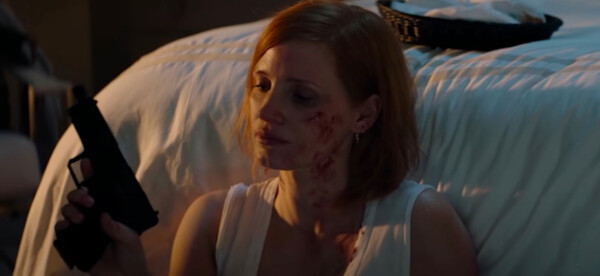
Image courtesy of Vertical Entertainment.
“Ava” Starring Jessica Chastain, John Malkovich, Common and others. Directed by Tate Taylor. 96 minutes. Rated R. Netflix.
Mladen’s take
“Ava,” starring Jessica Chastain as a hitwoman, gets good about halfway through the 96-minute movie. What’s the halfway grade on the scale from A to F? Correct. C. That’s the grade the movie gets from me.
Chastain is a very good actress, but what’s with very good actresses heading toward middle-middle to late-middle age and the urge to do action thrillers? We have Angelina Jolie as “Salt.” We have Charlize Theron as the matriarch of “The Old Guard.” Jennifer Garner is “Peppermint.” I imagine you can name others. Are Harrison Ford or Bruce Willis or Liam Neeson convincing as kick-your-ass man killers when they look their skins have turned to leather and their muscles are rippled rather than ripped? I loved the “The Expendables” trilogy, but only Antonio Banderas in TE3 looked somewhat like he was nimble enough to dodge bullets.
Ava is a former drunkard and Army super-soldier recruited by one of her then-commanders – played convincingly by John Malkovich as Duke until he fights and nearly kicks the shit out of much younger Simon (Colin Farrell) – to be the assassinator of guys who’ve done serious wrongs but avoided prison time. Simon is the head of the organization that arranges the hits. Duke and Ava, who are friends, too, are employees of said company.
We are led to believe that in most instances Ava moves in, takes out her target, and moves out with barely a ripple in the Force. But, of late, she’s started asking her marks what they had done that warranted the application of her skills before she applied them. For some reason, Simon is disturbed by Ava’s curiosity.
Between offing prominent baddies, Ava struggles with staying sober, tries to bed her sister’s fiancé (who was once Ava’s lover), and works hard and long to mend relations with her ailing mother, played nicely by Geena Davis. OK, so far so somewhat good, but, like pretty much every action thriller, it seems that very few, if any, other soldiers or mercenaries can shoot as good as our likeable but troubled protagonist. Or fight as good as Ava. Or take body blows like Ava, etc.
But, the real problem with the first half of the film is that it’s somewhat uninteresting because A. I could give a shit about her family woes and B. what’s wrong with knocking off a corrupt IMF economist? It’s when the movie gets personal, Ava moving to avenge Duke’s murder, that I started to enjoy the pretty redhead’s acumen and ability to focus.
“Ava” is a C, but that could be a rating that’s the result of my defective preference for straight-up violence. John Wick started puncturing Russian mobsters with knives and bullets because one of them killed his dog (which his wife gifted after her death) and stole his Mustang. I sympathize with both, though much more with the missing muscle car than a puppy. After that, the dead dog and the stolen hot rod were used by the mobsters to express disbelief about Wick’s motivation to kill them moments before he did so. Wick wanted to be left alone, but people kept interfering with his new life as a non-assassin. Ava, well, she’s portrayed as human. She wants to booze. She wants to copulate. She’s troubled by her mother’s, what, callousness and wants to repair their relationship or obtain her affirmation or whatever. Who cares? Not me, until Ava goes vengeful.
If you want to watch a movie about an assassin and the assassin’s detailed backstory, “Ava” is for you. I prefer my killers to be meticulous, stone-cold sociopaths with contempt for humanity, rather than inclination to become part of it.
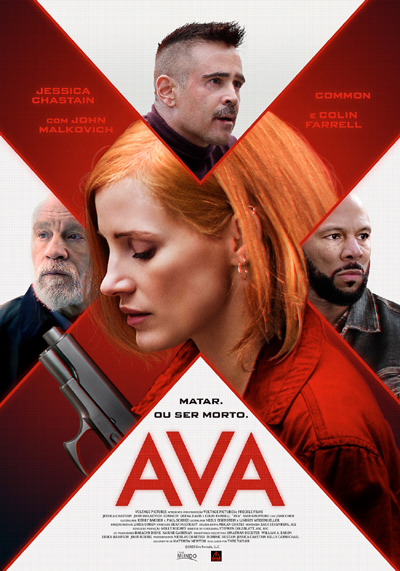
Del’s take
Much as it pains me I agree with the drift of Mladen’s review. I wasn’t a fan of “Ava.” Ironically, one of the movie’s co-stars appeared as the lead in a superior action flick many years ago. Oh, if “Ava” had only been half as good.
My problem with “Ava” is that it wants to be two movies – the story of Ava the recovering drunk and the story of Ava the badass lady assassin. For an action movie viewpoint character to have flaws is perfectly fine by me, but when half the movie is spent exploring family dynamics and attending 12-step meetings, the distraction of naval-gazing amounts to more than the focus and pacing can bear.
The movie seemed populated with clichéd characters – John Malkovich as the eccentric yet deadly handler, Colin Farrell as the ruthless higher up and Chastain herself as the out-of-control rogue operative who must be exterminated for the sake of the company’s reputation. All this strikes me as VERY familiar. Maybe if they had changed Ava’s name to “Jason.”
Acting was only so-so. Malkovich is good in everything he does but he typically plays one type of character – the kind of guy who, when you walked into your junior year situational ethics class, could be standing at the podium or slouched in the desk next to you. I’ve never understood the draw of Colin Farrell, who strikes me as a tabula rosa kinda guy, and Common was simply awful. I honestly think Shaquille O’Neal could have done a better job reciting those lines.
And then Chastain … what can I say? She was totally wrong for the part. Most of the time she seemed lost and confused, her face an expressionless slate, her eyes wide with … I don’t know, introspection? Valium? Beats me, but the effect was the same. Plus, and this is a biggie, she totally lacked the physicality to play the role. During many of her fight scenes she struck me as slow, uncoordinated and dare I say weak? I wasn’t convinced.
The one redeeming performance came from Geena Davis as Ava’s bitchy, judgmental mom who’s nevertheless happy to have her kid back home, toxic secrets and all. Davis is an actor’s actor and she seemed born into that role, just as she seemed born into all her roles. She was also the star of a much better action flick that some of you old farts may remember, 1996’s “The Long Kiss Goodnight.” Samantha Caine was the romp ’em, stomp ’em action hero that Ava should have been. If only they had handed Geena a gun.
“Ava” is mostly competent in the details but not so much in the view from 20,000 feet. With a better lead actor and a tightly focused plot it could have been a better movie. From me it gets a C-.
Mladen Rudman is a former journalist and technical writer. Del Stone Jr. is a former journalist and author.
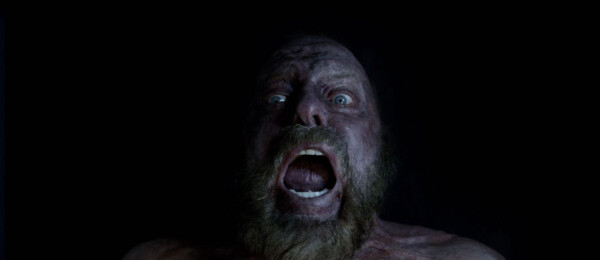
Image courtesy of Netflix.
“The Block Island Sound” Starring Chris Sheffield, Michaela McManus, Matilda Lawler, Neville Archambault, and others. Directed by Kevin McManus and Matthew McManus. 99 minutes. Unrated. Netflix.
Mladen’s take
Del warned me to avoid spoilers when I recapitulate the plot of “The Block Island Sound” because the film relies on keeping the source of the troubles endured by our protagonists secret.
So, here are a couple of sayings to help you meander through this review while I try to explain what the sci-fi-like, horror-ish “The Block Island Sound” is about without giving away the neat ending. To appreciate the ending, by the way, be sure to pay attention to the beginning of the movie. It’s the scene between mother and daughter talking about studying animals.
I’m borrowing the first indirect explanation of “The Block Island Sound” storyline from a couple of Star Trek movies: “The needs of the many outweigh the needs of the few.” I believe that’s a Spockism.
Then there’s “What’s good for the goose is good for the gander.” I have no idea where that saying originated.
The movie also portrays and warns about doing onto others, in this case marine fish, what you wouldn’t want done unto you. That truism is derived from the Bible or some other piece of historical fiction.
“The Block Island Sound” is a slo-mo film that constantly has the viewer wondering what the hell is going on. By slo-mo I mean action is limited and the story unfolds through the tension of a family that doesn’t get along. There are a couple of drunkards, the father and the son; a smart and altruistic sister and her cute daughter; an unempathetic and punitive sister; and a dead mother.
Other characters in the film are the gossip and law enforcement attitudes of a small, somewhat isolated community. A kook expounding all sorts of conspiracies about the Government, parasites, and I can’t recall what else is in the movie, too.
Semi-mass dyings of fish and birds and an apparition are also parts of the story.
“The Block Island Sound” takes place in the American Northeast, somewhere in the vicinity of Nantucket. The sea is blue-gray, as is the sky. The movie’s moodiness is similar to “The Vast of Night” or “Cosmos.”
The acting is good, even if the smart sister seems to be dumb occasionally though she’s a scientist. Chris Sheffield, playing emotionally tortured Harry, executes again and again some one of the finest examples of walking catatonia, the vacant stare and slackened face, the blank expression, a hypnotic state, describe it as you wish, I’ve seen in a movie.
Be patient watching “The Block Island Sound.” Everything is tied together at the end in pretty cool fashion. Disregard, to some degree, the family dysfunction that’s regurgitated throughout the film. It annoyed me, but I hung on until the credits rolled to see what caused the strangeness on the island and its local waters.
“The Block Island Sound” earns a B, just scraping past a B-, from me.

Del’s take
I won’t be as charitable as Mladen in grading “The Block Island Sound.” The movie was a tad schizophrenic for my tastes.
To amplify Mladen’s plot summary, the story is about a man caring for his Alzheimer’s-stricken father at the ancestral home on an island somewhere in the Northeast. His sister, who works for the Environmental Protection Agency, returns to the island with her daughter to study a series of bird and fish kills. When the father turns up missing and then deceased, another daughter, the bitchier of the two sisters, joins her siblings for the funeral. The brother resents his sisters for abandoning him to the care of their father. And now he’s seeing things. He’s drinking heavily. He’s falling apart.
For the most part the movie is competently made, and casting and script are fine (faint praise). My gripe is with the metastory. There are two stories at work here, and the McManus brothers do a much better job of telling one. The second story is not original in content or presentation.
Most interesting is the interaction between the siblings, all finely drawn by the actors. Sheffield does a good job as Harry, the suffering son who has remained behind to take care of his dementia-addled father while his two sisters pursue their lives unencumbered by familial obligations. McManus and Heidi Niedermeyer are equally effective as the two sisters who have left their ailing father in the hands of their brother, then snottily fault him for crumbling under the pressure of caregiving. The interplay between these three is sufficiently interesting to compel a watch, despite the fact that none of them is very likeable.
And the second story? It emerges slowly over the course of the action, until sometime in the second act when the climax is telegraphed, resulting in an anti-climax to wrap that branch of the narrative and the movie itself.
As many character studies go, the pacing of “The Block Island Sound” is slow, abetted by a depressing color palette of grays and steely blues, always cloudy skies, and a choppy Atlantic Ocean that does not give up its secrets. Likewise the tone is dark and funereal. You are watching the dissolution of a family as much as a mystery about dying fish and crows flying into windshields.
My sense is the overarching thematic imperative is one of loss – loss of soul due to the escalating infirmity of cognitive decline, loss of life on the part of those in the caregiver role, loss of empathy for those who have shirked their responsibilities and in the end, loss of humanity.
That’s a lot to digest in a movie that’s pitched in its trailer as being about something more congruent with a horror movie. Who wants to be entertained by grim reality when there’s a fun universe of exploding heads to be explored?
If the McManus brothers had left out the fish kills, bird kills and all the nonsense that followed, “The Block Island Sound” would have earned a B+ from me. As it is, the movie gets a C.
Mladen Rudman is a former journalist and technical writer. Del Stone Jr. is a former journalist and author.

Image courtesy of Next Entertainment World.
“Train to Busan Presents: Peninsula.” Starring Lee Jung-hyun, Dong-won Gang, Re Lee, Ye-won Lee, Hae-hyo Kwon, Kyo-hwan Koo, and others. Directed by Sang-ho Yeon. 115 minutes. Rated PG-13. Amazon pay-to-stream
Mladen’s take
There I sat, wavering. It was about three-fifths of the way through the South Korean movie “Train to Busan Presents: Peninsula.” My qualms included a meditation on the film’s weird title, which was clearly an example of success exploitation marketing. Was this semi-sequel to the excellent film “Train to Busan” worthy of a good grade or does it deserve a bad grade? And, then, came the straight-faced line: “Let’s get Mom.” Poof, I dropped into the “Better than Average” column, but only just.
Before I sum the plot, you’re owed a warning. Del the zombie-phile will praise this movie, maybe even slip it an A-. He’ll be wrong. The movie is one full grade lower, but worth watching. It cost me 55 cents to lease a 48-hour viewing window on Amazon.
Recall that “Train to Busan” introduced us to some very good action horror with an unremarkable plot very well executed. A bioengineering laboratory accidentally releases a contagion that transforms people into something akin to the rampaging quasi-dead hungry we first met in 2010’s “28 Hours Later.” In “T to B,” the story was driven by a father trying to keep his daughter alive, if I recall accurately, as the infected multiply and the state rapidly loses control of law and order. “T to B” possessed stunning special effects. The locomotive slowly motoring along while zombies clinging to the back of the machine pile on each other to make a squirming, yet flowing tail of organic debris was something else.
That “something else” was missing in “Peninsula.” The computer-generated special effects lacked believable physics of motion. The vehicles bulldozing through zombies, jumping roads, or smashing into each other seemed like Matchbox cars running the gauntlet of a plastic race course. Also, at times, “Peninsula” seemed very “Casshern”-like or “Alita: Battle Angel”-ish. The difference is that “Casshern,” a 2004 Japanese movie, and “Alita” of 2019 intentionally deployed the tinge of anime as part of the storytelling. “Peninsula,” which imagined quarantined South Korea four years after the “T to B” virus was unleashed, often portrayed dilapidated urban terrain or action scenes with the patina of a video game that had mated with anime to create an almost-cartoon. In short, the visual effects in “Peninsula” were surprisingly crappy.
Oh, the plot. A South Korean soldier loses his sister and nephew to zombie-itis, but manages to save his brother-in-law. A few years later, the pair gets sucked into returning to South Korea to retrieve a truck load of American dollars for an American gangster based in Hong Kong. If they and a couple of others succeed, they get half of $20 mil. That’s money that would get them out of the political limbo of being microbe-induced refugees. Naturally, the return to the Peninsula, get it, goes astray. Dong-won Gang, playing South Korea Army Capt. Jung Seok, gets pulled off a zombie dinner plate by feisty, hard-driving teenager Jooni, played by Re Lee, and her younger sister Ye-won Lee as Yu Jin. They flee to their hideout, where Jung meets resourceful, determined, and very pretty Min Jung. Min is played by Lee Jung-hyun. She’s the mom in “Let’s get Mom.” While Jung, Min, and the girls are good and likeable characters in the film, most of the bad guys are all pretty much clichés and fail to be unlikeable. The exception was Captain Seo, nicely portrayed by Kyo-hwan Koo as desperate and scheming to the end. He has no trouble shooting the old man and Mom to get the hell off the Peninsula.
The soundtrack in the film is good enough. There was a moment when I thought I heard a few stanzas, verses, whatever you call pieces of music, that sounded like an adventure tune in the video game “Halo.”
OK, Del, take it away with your take. Please don’t let the blubbery family scenes in “Peninsula” color your judgment as they did when you watched the last film we reviewed. We owe it to our growing readership to assess correctly the merits of a film.
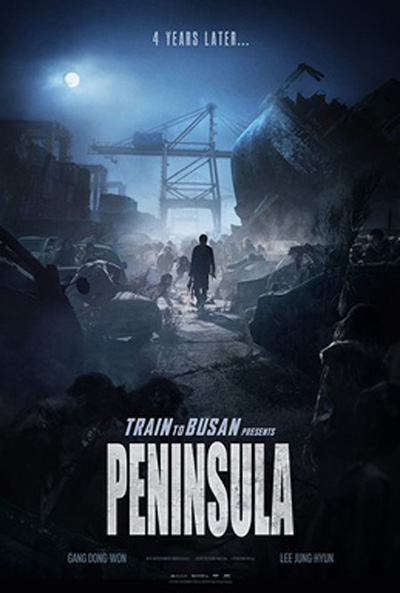
Del’s take
It was I who recommended to Mladen that we review “Peninsula.” It was not I who recommended that he tap the cooking sherry before writing his review.
He’s correct when he describes the putative prequel to “Peninsula,” “Train to Busan” as excellent. I remember foraging through Netflix one night, searching for something to watch, when I stumbled across “T to B.” Another hokey foreign zombie flick, I warned myself, before clicking the “play” button. Imagine my surprise when I discovered a modern classic in science fiction-horror, one I’ve added to my DVD collection. “T to B” is that good. I would rate it up there with the Zack Snyder remake of “Dawn of the Dead.”
So it was with great expectations that I forked over my 99 cents to watch “Peninsula.” (I’d like to know how Mladen managed to do that for 55 cents. Did he get the cooking sherry discount?)
To put it succinctly, I was not impressed. For these reasons:
1. It’s derivative. Take the premise of “28 Weeks Later,” throw in some “Escape from New York” and using crude, Frankensteined stitches graft on any road chase sequence from the “Mad Max” movies and you’ve got “Peninsula.”
2. Mladen was right about another aspect of the film – the special effects. They weren’t just bad. They were cartoonish, on par with “Speed Racer.” They completely ruined the movie for me because I’ve seen car chases and motorized mayhem done right – all that metal-crunching comprises a story of its own. You want a car chase? Consult George Miller. You don’t hand it to the CGI folks, and that’s what the creators did with “Peninsula.” Those scenes screamed “Fake!” and threw me out of the zombie-infested universe Sang-ho Yeon sought to create.
3. Many of the major characters were unlikable. As Mladen explained, the point of this group’s return to zombie-infested South Korea is to recover a truckload of American dollars. The deal is a small group will find the truck and drive it back to an Inchon dock, where it will be loaded aboard a ferry. The group gets half the $20 million and the crooks get the other half. Ahem. Of course. The crooks will most definitely abide by their end of the deal. Have you never heard of honor among thieves?
The movie is really about Gang Dong-won’s character attempting to redeem himself after refusing to help a family in need during the initial, hyper-frantic days of the zombie outbreak. As subtexts go it’s about as subtle as a Mar-a-Lago powder room and Jung-seok is such a weak and altruistic tormented-soul type that by mid-movie you’re hoping one of his putrid antagonists makes a snack of him.
4. Nitpicks. Why does a director spend a considerable chunk of screen time building tension and setting a deadline, and when that deadline arrives the director allows his characters to engage in long, deadline-busting soliloquies and dénouements?
How is it that a car will start after sitting idle four years?
Why are children always precocious and infallible?
Why are the elderly characters always expendable?
Why does a highway choked with wrecked and abandoned vehicles always have a lane open?
Why was South Korea simply abandoned? Is its net worth beneath the scope of recovery?
5. The version I saw was not subtitled. It was dubbed. Have I ever told you how much I hate dubbing? When you can see the character’s mouth moving while the dialogue track stopped three seconds ago?
Enough fussing. Bottom line: I was hoping for a movie that matched the off-the-rail entertainment punch of “Train to Busan” and what I got for my 99 cents (Really, Mladen? Fifty-five cents?) was something altogether different and, dare I say, less everything. I could wax all movie-review poetic and talk about the film’s emotional core or its resonance to the genre template but this is not a thirst trap for pretty words. Suffice it to say “Peninsula” was a disappointment.
For much better fare about the undead try “Cargo” or the unbelievably good series “Black Summer,” both on Netflix at no extra charge. For an even weirder take on the zombie genre try Arnold Schwarzenegger in “Maggie,” which you can find in some DVD bargain bins.
“Peninsula” gets a grade of C from me.
Mladen Rudman is a former journalist and technical writer. Del Stone Jr. is a former journalist and author.